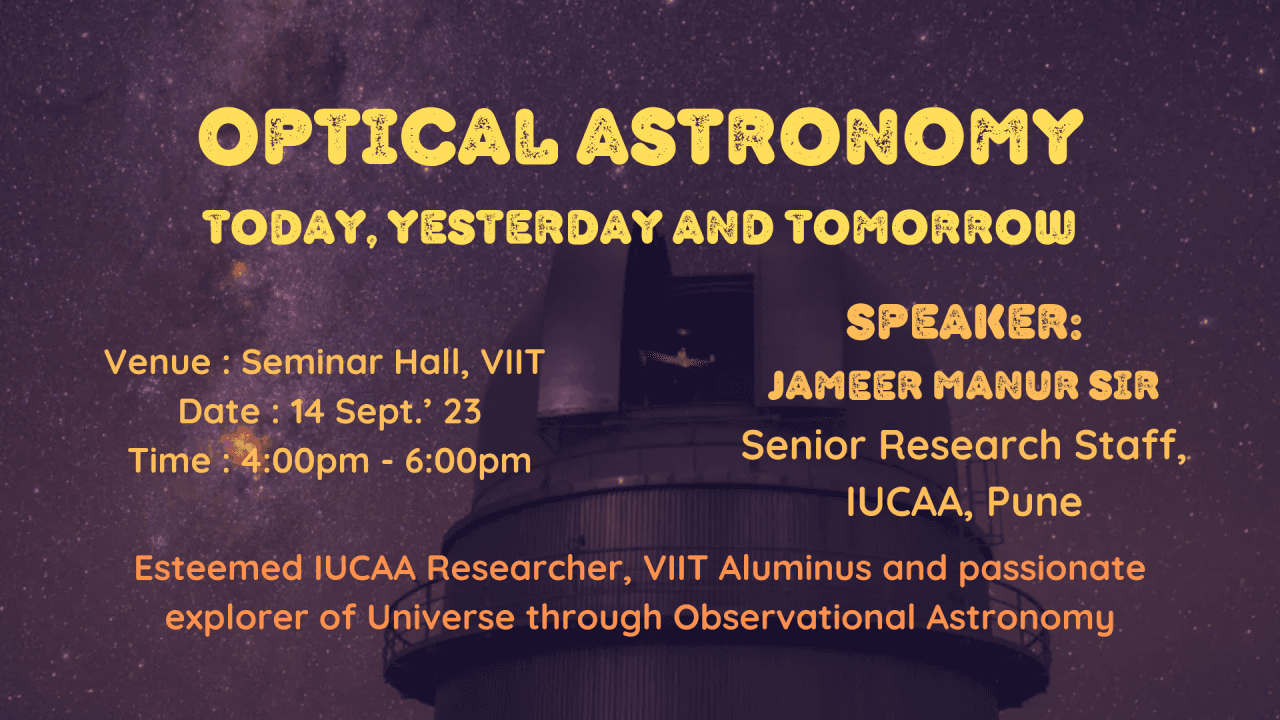Date: 23rd March’ 2024 Time: 2:00pm (1400) to 4:00pm (1600) IST
Venue: Classroom C201, VIIT College
Hosted by: Antariksh Club of VI
Attendees: Total 20 members

The internal talk on "Formation and Types of Galaxies" conducted by Shreyas from T.Y.B.Tech, Vishwakarma Institute of Technology , served as an engaging platform for astronomy enthusiasts to delve into the mysteries of the Galaxies. During Shreyas’s talk, attendees gained knowledge about significant historical moments in astronomy, such as Charles Messier's cataloguing of galaxies and William Herschel's groundbreaking drawing of the Milky Way. The session was equipped with the images of Milky Way, which were captured by Antariksh Club during its recent Star Party Visit. The Stellar Event of Star Party was also discussed by Shreyas, explaining even the minute details of the Journey through Stars.
History of the Galaxies:
The attendees were also told about time in 1785, when William Herschel drew the first illustration of the Milky Way, creating the foundation for astronomical observations to come. Charles Messier's list of celestial objects, which included several galaxies that Shreyas eventually discovered via his careful studies, was subsequently shown to the audience.
Great Debate and Distance Calculation:
The conversation then shifted to the historic Great Debate of 1920, in which Heber D. Curtis and Harlow Shapley argued passionately over the characteristics of spiral nebulae, leading to the eventual realisation that galaxies are unique objects in the universe. With great amazement, Shreyas explained how astronomers determine distances using techniques like the Parallax method and Cepheid variables, illuminating the complex procedures used to explore the immensity of space.
Galaxies and Classification:
Shreyas delved more into the idea that galaxies are formed from gravitationally bound interstellar debris, piquing the audience's interest in the genesis of these cosmic formations. The Hubble Classification System was used to classify galaxies and illustrate the wide range of galaxy types that exist, such as lenticular, irregular, spiral, and elliptical.
Examples:
Shreyas gave interesting examples, such the Seyfert galaxies, like NGC 5728, that show modest energy emissions from active galactic centres. Talks about galactic collisions, such as the merger of NGC 5444 and NGC 5445, which showed how dynamic interactions shape the universe, fascinated the crowd.
Question: "If the universe is expanding, why are the Andromeda and Milky Way galaxies colliding?"
Shreyas explained that while the universe is indeed expanding overall, gravity can cause local structures, such as galaxies within galaxy clusters, to overcome this expansion. In the case of the Andromeda and Milky Way galaxies, their mutual gravitational attraction is causing them to approach each other despite the expansion of the universe. This collision is a result of the intricate interplay between gravitational forces and cosmic expansion on different scales.
Question: "What existed before the Big Bang?"
Shreyas had discussed the concept of a singularity, where the laws of physics break down, making it difficult to ascertain what existed before the Big Bang. He also moved on and explained that our current understanding of the universe's origins is limited by the boundaries of our scientific knowledge, and theories such as the inflationary model propose that the universe underwent rapid expansion from a highly compressed state immediately preceding the Big Bang.
Question: "Can you explain the difference between the Big Bang theory and the Steady State theory?"
Shreyas had outlined that the Big Bang theory posits that the universe began from a singular point in an explosive event approximately 13.8 billion years ago, expanding and evolving into its current state. On the other hand, the Steady State theory suggests that the universe has always existed in a steady state without a beginning or end, with new matter continuously created to maintain a constant density as the universe expands. However, observational evidence, such as the cosmic microwave background radiation, strongly supports the Big Bang model over the Steady State theory.
GROUP Discussion:
After the thought-provoking presentation, there was a vibrant group discussion where participants avidly discussed themes that went beyond the talk's focus. Discussions explored the mysterious fields of wormholes and alternate cosmologies, creating a cooperative atmosphere where thoughts were allowed to flow.
The lecture sparked awe and excitement about the wonders of the cosmos in addition to improving the audience' knowledge of galaxies. Everyone who attended was deeply impacted by Shreyas's captivating presentation style and thorough treatment of the subject, which helped to create a community of fervent astronomers committed to understanding the universe.



